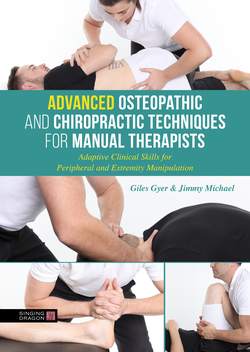Читать книгу Advanced Osteopathic and Chiropractic Techniques for Manual Therapists - Giles Gyer - Страница 8
На сайте Литреса книга снята с продажи.
Neuromuscular effects Muscle activation
ОглавлениеThe muscular reflexogenic response is an important theory that is frequently used to explain the mechanism of spinal manipulation. The muscles of the human body have some reflex responses, by means of their reflex arcs, to protect themselves from potentially harmful force (Evans 2002). In manual therapy literature, the reflexogenic effect is often explained using one of the prominent theories of pain, the pain–spasm–pain cycle (Travell, Rinzler and Herman 1942), which suggests that pain causes muscular hyperactivity (spasm) and muscle spasm reflexly produces pain, establishing a self-perpetuating cycle. Although this pain model lacks unequivocal support from the literature (van Dieën, Selen and Cholewicki 2003), there is enough evidence in support of the fact that low back pain (LBP) patients experience significantly higher levels of paraspinal muscle activity than normal healthy individuals during static postures (Geisser et al. 2004; Hodges and Moseley 2003; Lewis et al. 2012). Spinal manipulation is thought to disrupt the pain–spasm–pain cycle by reducing muscle activity through reflex pathways. Pickar (2002) postulated that the mechanical stimulus applied during manipulation on paraspinal tissues might influence the sensory receptors to cause muscle inhibition, and suggested that afferent stimuli would target this inhibition as a reflex response. Herzog (2000) proposed that the neuromuscular response to spinal manipulation could involve two reflex pathways – the capsule mechanoreceptor pathway and the muscle spindle pathway – and these pathways might differentiate by muscle activity onset delay.
EMG signals are commonly used to quantify changes in muscle activation following spinal manipulation. Amplitude and timing of the EMG signal are the two aspects that quantify muscle activity changes (Currie et al. 2016). Experimental studies done to assess neuromuscular responses to spinal manipulation reported both increases and decreases in EMG amplitude following manipulation (Bicalho et al. 2010; Ferreira, Ferreira and Hodges 2007; Lehman 2012; Lehman and McGill 2001). It is to be noted that most authors, including Lehman and McGill (2001), reported a reduction of paraspinal muscle activity following manipulation in resting phase. The conflicting results, however, appeared when EMG amplitudes were analysed during dynamic activity (flexion or extension). Nevertheless, most of the high-quality experiments published to date reported reduced paraspinal voluntary EMG amplitude during extension and relaxation phases (Lehman 2012). The changes in EMG amplitude in response to manipulation indicate that the underlying mechanism of spinal manipulation may involve the disruption of the pain–spasm–pain model.
The timing of the EMG signal is another measure of the muscle activity changes. Muscle activity onset delay quantifies the reflex response of a given spinal manipulation. Onset delay of a muscle following manipulation is too short, and varies in a wide range, from 1 to 400 milliseconds (Colloca, Keller and Gunzburg 2003; Currie et al. 2016; Keller, Colloca and Gunzburg 2003); thus, it is unlikely to be activated voluntarily (Herzog 2000). On the other hand, because a spinal reflex is assumed to take place within 120 milliseconds (Wilder et al. 1996), there is a high likelihood that a spinal reflex response may be involved with the muscle activity onset delay. Furthermore, in a recent study Currie et al. (2016) quantified differences in muscle activity onset delay between symptomatic and asymptomatic participants following lumbar manipulation, and found that those with LBP (symptomatic) had longer onset delays than their healthy (asymptomatic) counterparts, although the difference in timing was only 5 milliseconds. The authors suggested that the delayed neuromuscular response in the symptomatic group in response to spinal manipulation might be due to the involvement of capsule mechanoreceptor pathways. In support of this claim, they cited Herzog’s (2000) work, where the author anticipated the faster activation of the muscle spindle pathways than capsular reflex pathways because of their reliance on large diameter Ia afferents.
From the above discussion, it is evident that spinal manipulation results in neuromuscular responses, involves spinal reflex pathways and may reduce muscle hyperactivity. However, it needs to be investigated whether the evoked short-latency changes in EMG amplitude and timing following manipulation indicate a clinically significant outcome or merely a short-term effect.
